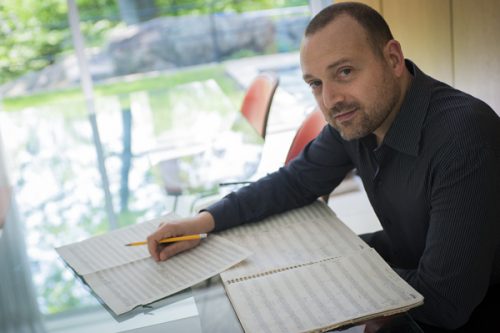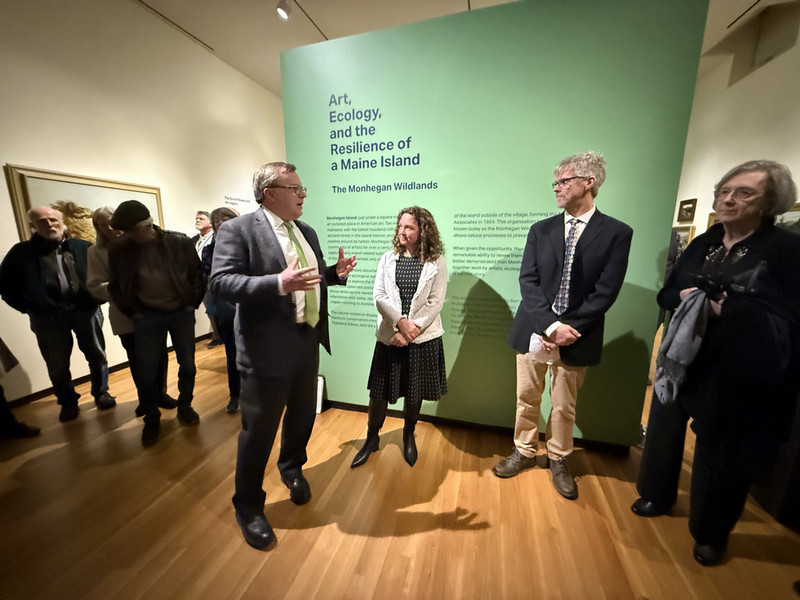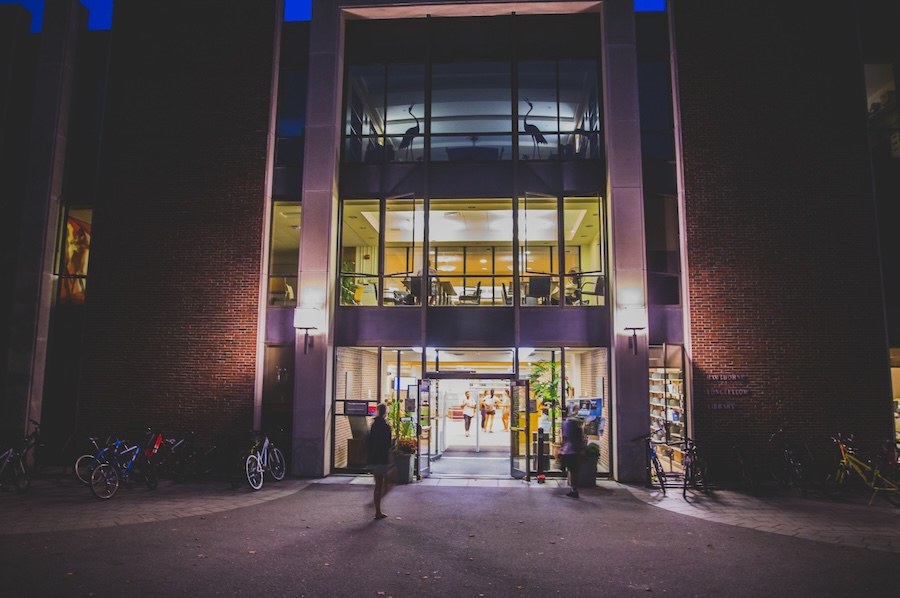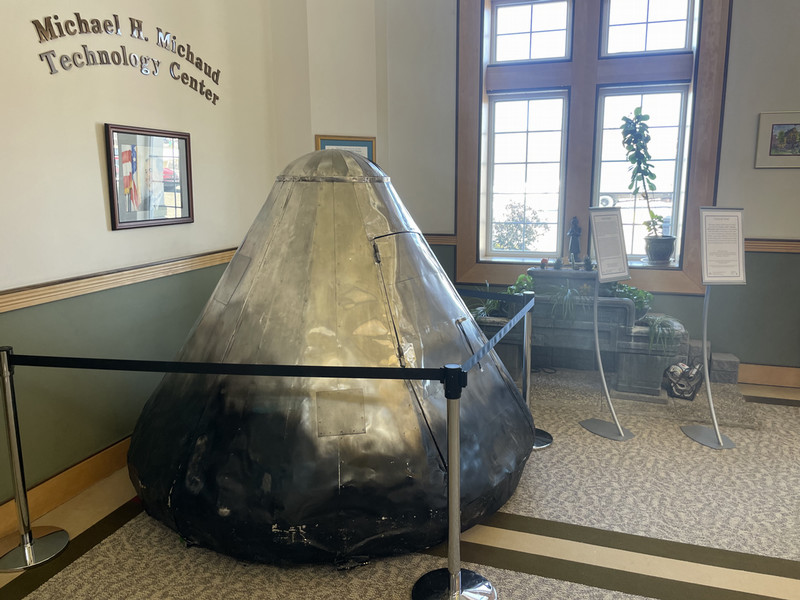Interview with Derek Bermal, Artistic Director of the American Composers Orchestra at Carnegie Hall and faculty, Bowdoin International Music Festival
By Bowdoin College Museum of Art
Could you please tell us a little bit about your background and your role at the Bowdoin International Music Festival?
I’m composer-in-residence at the festival. My first experience at BIMF, more than 20 years ago, was as a composition student! Eight years ago I was first invited as a faculty member, and I’ve returned every summer since. I enjoy working with such talented students from all over the world. However, my role at the festival extends beyond teaching and includes curating the Gamper Festival of Contemporary Music, designing the composition program, helping to invite guest composers, and planning new projects, like the one on which we’re embarking with the Museum this year. The artistic directors of the festival, Dave and Phil Ying, have been fantastic collaborators, as they are passionate advocates for contemporary music and interdisciplinary work.
We’re fascinated by your suggestion that the students create musical responses to works of art that interest them. What inspired that idea? Is there a larger history? Have you done such work yourself?
Creating art usually involves inspiration and/or transformation. Some compositional ideas spring directly from abstract musical forms, but ideas are often mapped from one discipline to another—inspired by another work of art, or a natural phenomenon, a historical (or current) event, or a theory from science or philosophy. Many great musical compositions were directly influenced by works of art. For example, Mussorgsky’s “Pictures at an Exhibition” or Morton Feldman’s “Rothko Chapel”. Regarding my own experience, in 2006 Wynton Marsalis commissioned me to write a concerto for his Lincoln Center Jazz Orchestra, along with the American Composers Orchestra. I decided to base the work on “The Migration Series,” a cycle of sixty paintings by the Harlem artist Jacob Lawrence. I had been fascinated by Lawrence’s seminal work ever since witnessing it as a child, and creating this tribute was a cathartic life experience for me. Over the years, as I’ve gotten to know Bowdoin’s fantastic collection, I have encouraged the composers to explore the Museum. After our first collaboration with Luke DuBois last year, I felt excited for the next chapter. My wife Andreia Pinto Correia, who also teaches at the festival, suggested that the composers write works inspired by pieces at the Museum. I extended this idea to the Gamper Festival of Contemporary Music, where we’ll present several compositions based on the work of various visual artists, including Winslow Homer, among others.
What do you see as the relationship between visual art and music? What does it mean to create a musical “equivalent” for something visual? Some people may know about the phenomenon of “synesthesia,” in which the brain spontaneously creates intersections between senses such as taste, sight, and sound. But is there something above and beyond this?
In the most tangible way, music may be closest to theatre and dance, two other temporal arts. However, terms from visual art are often used to describe music, and vice-versa: counterpoint, embellishment, harmony, dissonance, tonality, rhythm, sequence, variation, accent, tension, blend. These cognates do not always correspond exactly in meaning, but the use of similar language implies a strong conceptual association. As to synesthesia, musicians often use “color” when referring timbre or texture in sound. Many composers were acknowledged synesthetics, including Alexander Scriabin, who specifies particular colored lights to be illuminated throughout his orchestral work “Prometheus”; Olivier Messiaen, whose “Couleurs de la cité celeste” indicates exact hues that correspond to his scale choices; or Michael Torke, whose titles—”Ecstatic Orange”, “The Yellow Pages”, “Bright Blue Music”—refer to the particular colors that he ascribes to different harmonies. That said, the neurologist Oliver Sacks has written that it’s impossible to draw any conclusions from all these synesthetics’ assertions, as their (utterly distinct) correlations are personal and not particularly consistent.
Could you speak a little bit about the relationship of “contemporary” and “classical” music? How do the lessons of recent and historical musical composition intersect in the training you offer? Are there particular types of instruments for which your students are creating compositions, or are they more interested in producing certain sorts of sounds or melodies?
I use the term “concert” music, because it refers to music written for attentive listening, usually in quiet environments; the term differentiates the music from, for example, film music, advertising music, video game music, and a large percentage of pop music. Unfortunately the widespread norm for referring to contemporary concert music is “modern classical music,” which is a bit of an oxymoron, since the classical period ended roughly two centuries ago. Of course concert music–especially in instrumentation and certain formal and performative conventions– may bear some resemblance to that of “classical” composers like Haydn, Mozart, and Schubert, who were interested in vernacular genres of their day. But music written today may be influenced by styles from all over the world, from jazz to salsa music to Tuvan throat-singing to West African drumming, and on and on; the term “classical” seems to disregard, even actively dismiss, this diversity. For our museum project, the composers will choose from instruments present at the festival. I predict you’ll see and hear violin, viola, cello, double bass, flute, clarinet, oboe, bassoon, (French) horn, harp, and various percussion. And maybe some surprises!
What do you anticipate the process of composition might be like for the students? What should the audience who attends their performances on the afternoon of Saturday, July 28th be listening for?
I’d like to think that each composer will choose a work that inspires them, in whatever way is relevant to them. Some may write melodies and harmonies, others will start from a rhythmic foundation, still others might respond more abstractly, using unusual textures and extended techniques on the instruments to convey a particular mood or atmosphere. Some might incorporate extramusical elements, like text or movement. Perhaps the composers will offer a short, personal introduction to their piece, but I feel that the most empowering, enriching, and “dangerous” aspect of art is that every audience member engages with the work in their own way. So I wouldn’t want to didactically suggest any specific way of listening to a new work, aside from keeping an open mind.
Is there anything else you’d like to add?
I’m so thrilled that we’re finding a way to link the Museum’s extraordinary collection with the creative spirit of our composers. It’s a great way to begin what I hope will be an ongoing collaboration!



